Report: AnimaSyros 2022 – An Intimate Greek Festival Experience
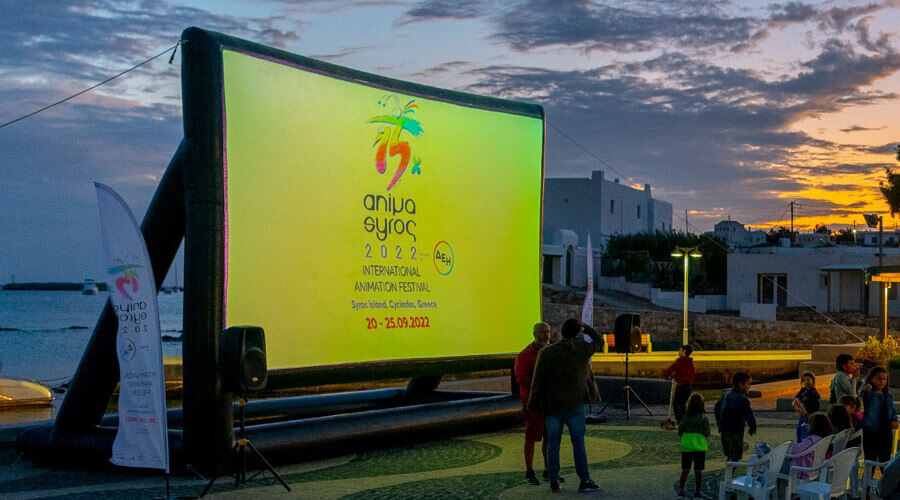
Wow. The first few moments after stepping off the ferry into Syros, my expectations had already been exceeded. I had already known about AnimaSyros festival for a good few years – indeed, I had attended their online ‘Phygital’ offering for the past two years through the pandemic – but I wasn’t quite prepared to step off into such a wonderful self-contained world of animation like this.
Every festival has its own little charms, and this one started with the journey – no, the adventure – to get there. Coming from London, a three-hour flight to Athens was followed by tranquil four-hour ferry journey across the Aegean Sea – not a bad way to ease into a festival, and one that built the anticipation nicely. Unfortunately, due to the travel times, I was unable to be there for opening or closing ceremonies, but this set me up perfectly to experience the festival in mid-flow for the two full days that I was there.
I should mention that Syros is the name of the Greek island itself; the festival is hosted in the small town (although one of Syros’ largest) of Hermoupolis. The first thing that hit me was the visual presence of the festival EVERYWHERE. Banners flying in the town square, posters everywhere, craft shops, bars and restaurants displaying ‘festival discount’ signs. If you were a resident or tourist, there is no way you could not be aware of the animation festivities taking place that week. I loved this community integration.
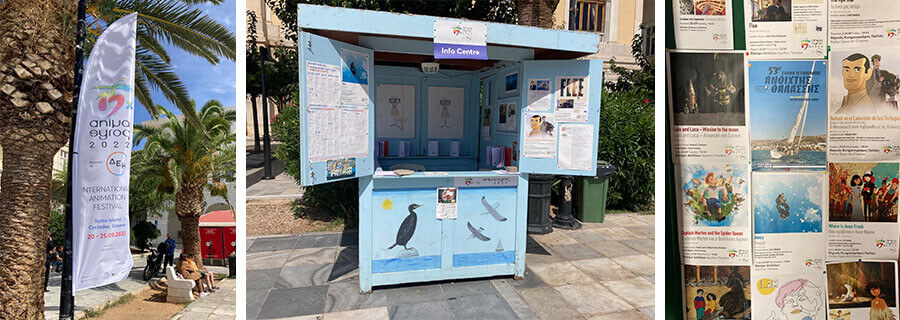
What to expect from AnimaSyros
2022 marked the 15th edition of AnimaSyros. Having been founded in 2008, and weathering 2 editions during the pandemic, this year saw the festival open up fully to the public and world again. Although there is a hive of activity taking place over 6 days, there are distinctively two sides to the festival: screenings and industry.
One of the things that impresses the most about AnimaSyros, is how they enable everything to be free and open to the public. Not only could residents turn up to the many open air and theatre screenings, these were also made available online for 24 hours (with worldwide access).
The free access also applied to industry events – the Agora marketplace – where talks and masterclasses were full of Greek students and international professionals alike. These were also made free online (and can still be viewed, here). More on Agora later, though.
There was a very relaxed atmosphere around the schedule – with the majority of industry talks taking place during the afternoon, and most screenings taking place in the evening. This no doubt helped encourage more members of the public attend – I enjoyed seeing random dog walkers and families drop in to the open air screenings. Additionally, if you are attending the festival as a filmmaker or member of the industry, there are a number of friendly and inviting parties and networking events organised where you can meet the directors and members of the Greek animation community.
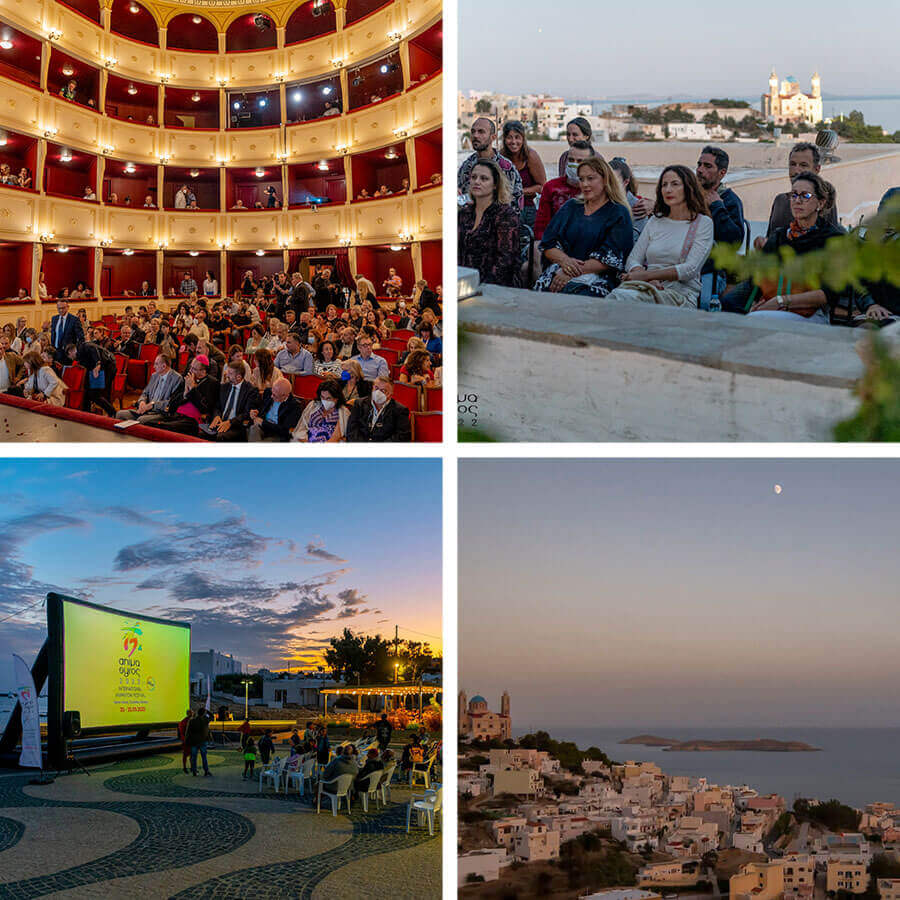
Screenings & Films
Two hundred films from 43 countries made up this year’s film selection, which competed within eight competition sections. Aside from the usual categories (International, Student, Commissioned, Kids, and Feature) there were two Greek competition screenings, showcasing home-grown talent; plus, this year saw a number of focuses on other European countries: Stand with Ukraine, a Norway tribute, and The Baltic animation tribute (which celebrated shorts from Estonia, Latvia and Lithuania). There is also a unique award that can be given to any film that promotes the fundamental values of the European Union. The European Values Award recipient can originate from any country in the world – not just the EU – and this year it was awarded to Hungary’s Cured by Márton Csutorás – a film about conversion therapy and the absurd statements surrounding homosexuality.
Cured was also given a special mention in the Animapride competition – one of my favourite screening events of the festival. Animapride featured 11 shorts on various themes that highlight important aspects of the LGBTQI movement; some light-hearted and humorous, while others incredibly brutal and hard hitting. Your Name (Paulo Patrício) was the most difficult film to watch – a 24-minute documentary-style animation about the murder of trans woman Gisberta Salce Júnior. On the lighter side was Dating Internet Strangers (Eduardo Wahrhaftig) which was an instant audience favourite; tackling the all too familiar experiences of dating apps. The winner, though, was the more accessible short Sasha (Sergei Chiviriga) about a snail forced to discover the truth about his sexual identity.
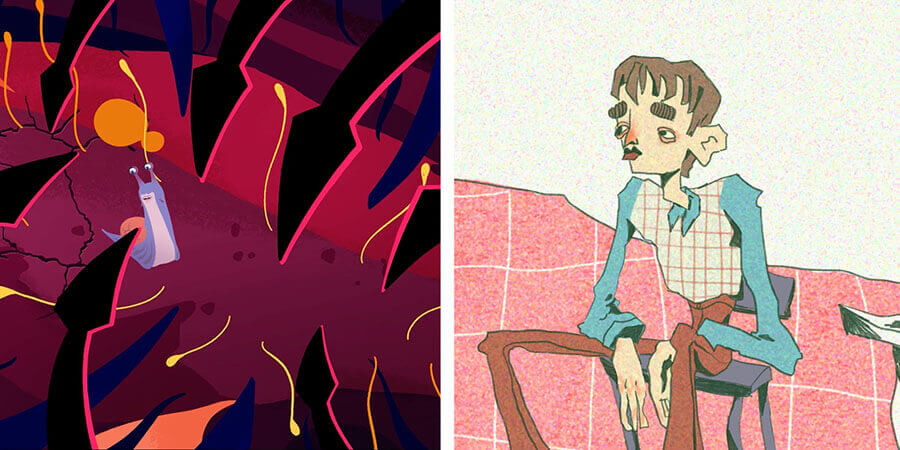
‘Sasha’ by Sergei Chiviriga (left) and ‘Cured’ by Márton Csutorás
Outdoor screenings are a key staple of AnimSyros – every night there was at least one taking place in a different stunning location. My first, and unfortunately only, outdoor screening was the family friendly “Selection Of Films From Animasyros 2022”. Taking place on a giant screen in front of the City Hall, local residents, children and animators alike all gathered on the steps on this balmy late summer evening. It was a pleasure just to watch random people come and go as they liked – with everyone enjoying animated films that they would otherwise not have seen.
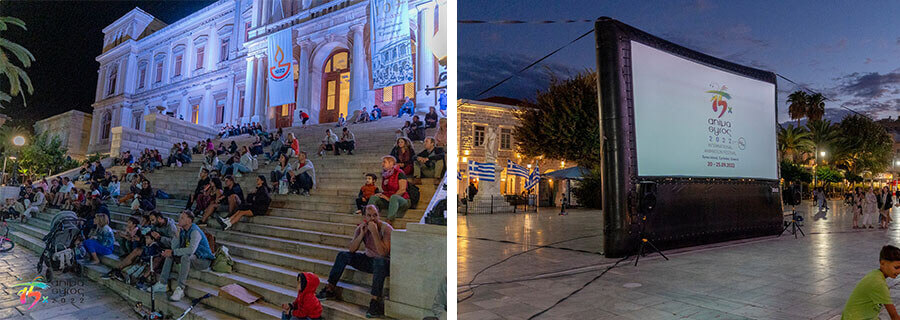
Agora, the market
The ‘Agora’ is more of what you would consider the ‘industry’ side of the festival; roundtables, masterclasses and a pitching forum. This four-day event is offered for free, both live and on streaming on YouTube. (You can still catch up with 4 sessions and 2 masterclasses here.)
The format is simple: each event lasts a digestible 20-30 minutes with 10-minutes of Q&A. This keeps everyone attentive and the momentum going, with short breaks here and there. It is surprising how much you feel you’ve learnt come the end of the day!
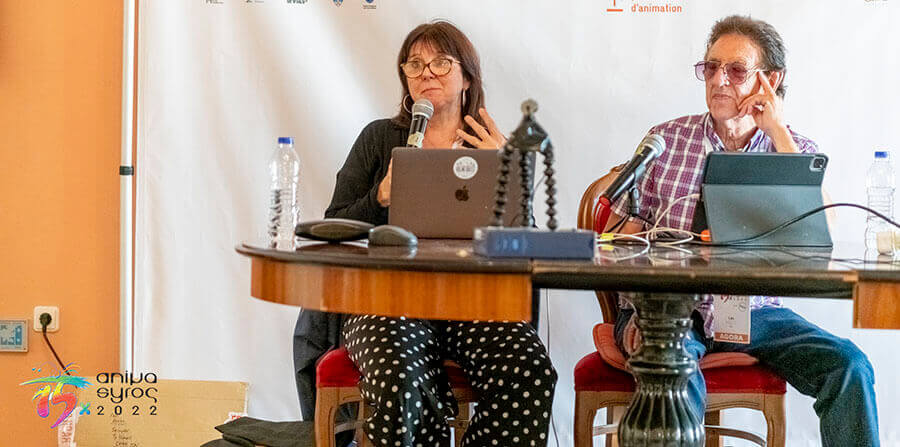
Joanna Quinn and Les Mills – ‘Behind the Scenes of Affairs of the Art
This year saw 50 panellists from 15 countries take part, with events including a Joanna Quinn’s ‘Behind the Scenes of Affairs of the Art’, Graphic Novels to Animated Films, and Animating the Museum Experience. Unfortunately, these all took place before I arrived, but I was fortunate to see:
Pitching Forum:
The closing event of Agora sees 5 projects being pitched to the public and animation professionals. Projects must be at an early stage of development, as the winning pitch is awarded a 1-month stay in France to work on their film, organised by NEF Animation.
The winning pitch was Seasons of the Day – an interesting concept about the snapshots of events that make up our memories, based on 4 different family member’s accounts. Two other projects also caught my eye: Offside – a new short from Estonian Director Sander Joon that tackles segregation, being trapped, and finding your place, through the metaphor of football. I also really enjoyed the pitch for Three Comma Fourteen (Portugal), which tackles ADHT in children and the reasons why adults diagnose it. Definitely three films to watch out for.
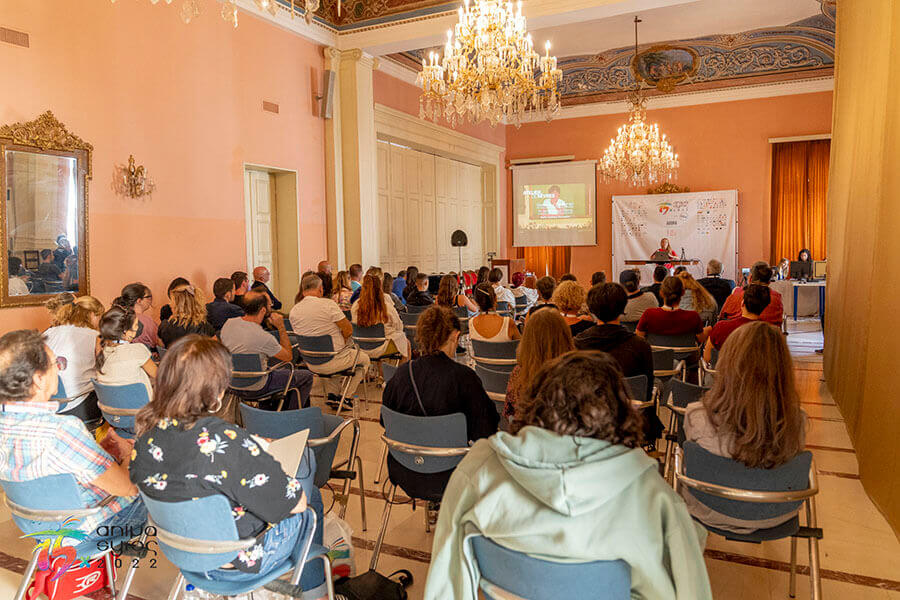
The Agora venue
In Conversation with Chris Nee, Creator of Netflix Series “We the People”:
This was one of my Agora highlights. Although I know Chris Nee’s work (Doc McStuffins), I have to admit to only seeing one episode of We the People, which is a 10-part series that uses music to teach the basics of rights and citizenship in the US. That episode was ‘Taxes’ by Victoria Vincent, and was screened at Annecy this year. Incidentally, it is also one of Nee’s favourites.
With a beer in her hand, Nee opened up about the journey of producing this series, the challenges of creating a series with 10 different directors and 10 different musicians, and amusing anecdotes about working with the Obamas – including how she once disagreed with one of Barack Obama’s production notes! You can watch the full conversation here.
Art of Pitching:
Another of my favourite masterclasses was the Art of Pitching, with Alison Mann (Fourth Wall Management), and Asalle Tanha (Cartoon Network). They gave some very insightful tips and advice on how to pitch and what information you should include. The full talk can be viewed here, but here are some of my favourite takeaway pointers:
- Be patient with yourself. Some people’s careers don’t start until they’re 45 or 50 years old
- It is difficult to get new IP commissioned at the moment, as the networks/studios are still dealing with the pandemic repercussions and are playing it safer with established IP at the moment
- Pitch meetings are brief – maybe 15 minutes – you need to grab their attention in the first 10 second!
- If you don’t get questions at the end of your pitch, they don’t like your idea(!)
Animation in the Baltic Countries:
Finally, there was a very informative discussion on the state of animation in the Baltic countries (Latvia, Lithuania, and Estonia) which examined how alike, but different, each were and how much money was being invested into animation. Although each of the 3 countries have a lot of international success with short films, it seems that a shift is slowly being made towards feature films. This lively discussion, which featured stats on what was being made, can be watched in its entirety here.
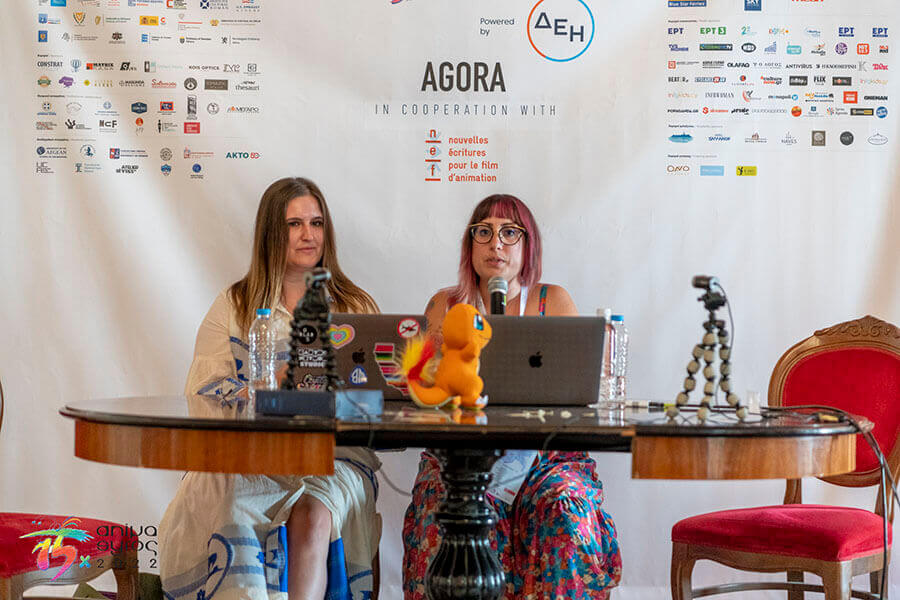
Alison Mann and Asalle Tanha – The Art of Pitching
Greek Animation
It was great to see what is currently happening in the Greek animation industry at first hand, as there were many roundtables, talks and screenings than focused on Greece, naturally. Having seen the excellent and exciting pitch for My Superhero Husband in Annecy, where the series was awarded first prize during the MIFA pitches, it was great to have an update of where the project is at. This Greek children’s series, which centres on 2 superheroes who are trying their best to be good heroes and husbands to each other, was first pitched at Agora in 2019 and has just returned from Cartoon Forum 2022 to even more applause – watch this space!

My Superhero Husband (left) and Aris Kaplanidis and Ilias Roumeliotis discussing Woman of ’22
As I always do when visiting a festival abroad, I made sure to view the national competition screenings, of which Greece had two, which showcased 21 shorts. One of my favourite films – Canary (Chrysoula Korovesi & Marios Gampierakis) – using the very visceral, gritty medium of charcoal on paper to tell the relationship of a coal miner and canary, was awarded Best Greek film. A special mention went to Travel Bugs by Fokion Xenos (Heatwave) – a stop motion short that forms part of a series currently in development.

‘Canary’ by Chrysoula Korovesi & Marios Gampierakis (left) and ‘Travel Bugs’ by Fokion Xenos
One project to look out for in a few years is the feature film Woman of ’22. This 80-minute animated documentary will be based on the real accounts from woman that survived the Asia Minor Catastrophe, which happened 100 years ago. Aris Kaplanidis and Ilias Roumeliotis gave audiences a first look at the trailer during this work in progress talk, although it is unfortunately not available online yet.
The Greek animation community has been represented by the animation association ASIFA HELLAS since 2008 – the same year that AnimaSyros was founded. Since then, they have been continually pushing to promote their industry and forge new relationships via a number of national incentives and international networking. For more information, visit asifahellas.eu/en.
Incidentally, as a footnote, an animated documentary about the festival’s host city, is in the works – Hellenic Place: Hermoupolis. The 17 minute ani-doc is written by festival president Vassilis C. Karamitsanis, with festival director Maria Anestopoulou acting as executive producer. Watch this space!

AnimaSyros parties and networking
A festival is more than just the events; it is the smiles of the volunteers, the community being enveloped by films and activities, the smells from shops & restaurants, and strangers you end up meeting. Despite there being more than 4,500 in attendance, AnimaSyros still retains that intimate quality that makes an animation festival so memorable and precious an experience. This was a true mix of public and industry coming together, enjoying animation in all its forms.
We would like to thank Maria Anestopoulou, Vassilis C. Karamitsanis, and the whole festival team for inviting us – we can’t wait to find out what 2023 has in store!
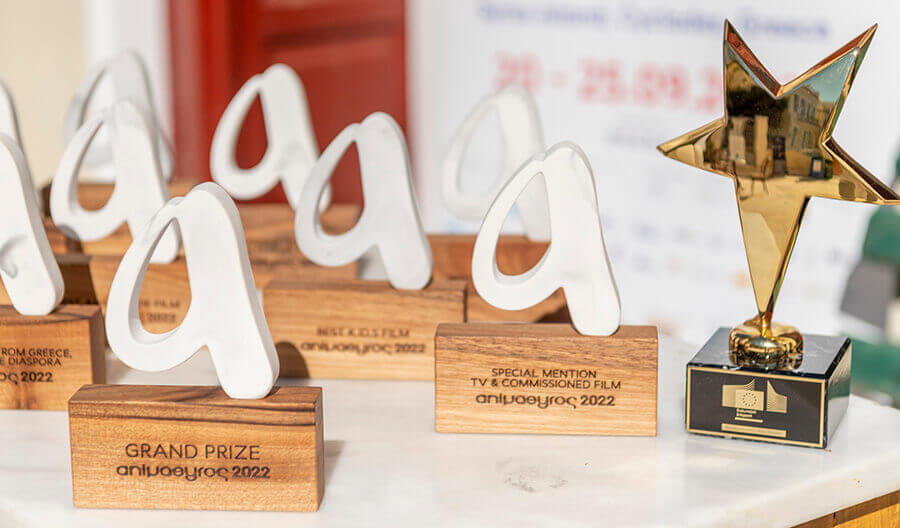
Winners & Jury Statements
International Competition Prize
Dog-Apartment – Priit Tender (Estonia)
Jury statement: “We are plunged into a wonderfully bleak world where the absurd is ordinary, observing the daily life of a man very concerned with finding his own means of subsistence. To achieve this, he has to take risks and accept a world where he has to give the best of himself. It is very well constructed and the visual ideas are extremely strong and stayed with us for a long time.”
Special mention: Steakhouse – Špela ČADEŽ ( Slovenia)
Greek Competition Prize
Καναρίνι(Canary) – Chrysoula Korovesi & Marios Gampierakis (Greece)
Jury statement: “In this film we go down the mine with miners and the canaries that protect them from the gas fumes. The coal drawings are animated in a very fluid way with a very simple and exciting soundtrack.”
Special mention: Travel Bugs – Fokion Xenos (Greece)
Student Competition Prize
La Bride – Nicolas Piret (Belgium)
Jury statement: “Playing a clever game between out-of-field and sound design, this film immerses us in a drawn universe where we tense up until we reach a taste of freedom. With this work the director gives us a sense of hope that the world cannot afford to lose.”
Special mention: Persona – Sujin MOON (South Korea)
TV & Comissioned Films Prize
Funny Birds – Charlie Belin (France)
Jury statement: “An elliptically crafted, fascinating coming-of-age story, where young, shy Ellie, a bird admirer, through an adventurous journey to an island, achieves her personal liberation and catharsis.”
Special mention: Thin Thing, music video by the band The Smile – Cristóbal León and Joaquín Cociña (Chile)
K.ID.S
Laika & Nemo – Jan Gadermann, Sebastian Gadow (Germany)
Jury statement: “Laika & Nemo is a very original story that explores the reality of loneliness and exclusion, the absurdity of bullying and the liberating power of human connection. Every aspect of the film (story, characters, animation, art direction, stage design, photography, sound and music) is thoroughly planned and well though out, producing a consistent and overall captivating result. Based not on dialogue but on visual choices and surprising details the film clearly communicates the reassuring message that the cycle of loneliness can be broken. Its’ visual universe resonates with the way children experience the world and at the same time educates and inspires with its’ aesthetics. Even if Laika and Nemo wasn’t a technically impeccable film it would still be a captivating, original story. But it is.”
Special mention: Paper planes – Siew May Khoo, Jay Septimo, Pamela Farhat, Michel Doumit (Lebanon)
European Values Award: #ThisIsEU
Cured – Márton Csutorás (Hungary)
Jury statement: “In a world that is constantly changing and probably not for the better, this mokcumentary is a powerful reminder that tolerance and respect towards the different is essential for a more humane society – and a strong safeguard for the future generations.”
Animapride Award
Sasha – Sergei Chiviriga (Romania)
Jury statement: “What made Sasha stand out were many elements. The visual style, admittedly pleasant to the eye, made it welcoming to all audiences. Its message, the discovery of our own sexual identity, was portrayed in a marvellous way via the use of snails. As it is known, snails have both male and female genitals. Self-discovery is key in this film as the main character witnesses his kin assume both roles which are not only depicted visually, but also with admirable vocal performances, assisting the audience in comprehending the ‘switch’ from one gender to the other. The message of inclusion and diversity, literally encapsulates the whole LGBTQI spectrum in this short film, as it finishes off with, no pun intended, the main character accepting not only oneself but others for being whoever they wish to be at any given time, simply because it’s in our nature.”
Special mention: Cured – Márton Csutorás (Hungary)
Agora 2022 Best Pich
Seasons of the Day – Vincent Tsui & Mavra Peponi
Feature Competition Audience Prize
“Flee” – Jonas Poher Rasmussen (Denmark)
All photos are copyright to Alexandros Petrakis | Inbulb


